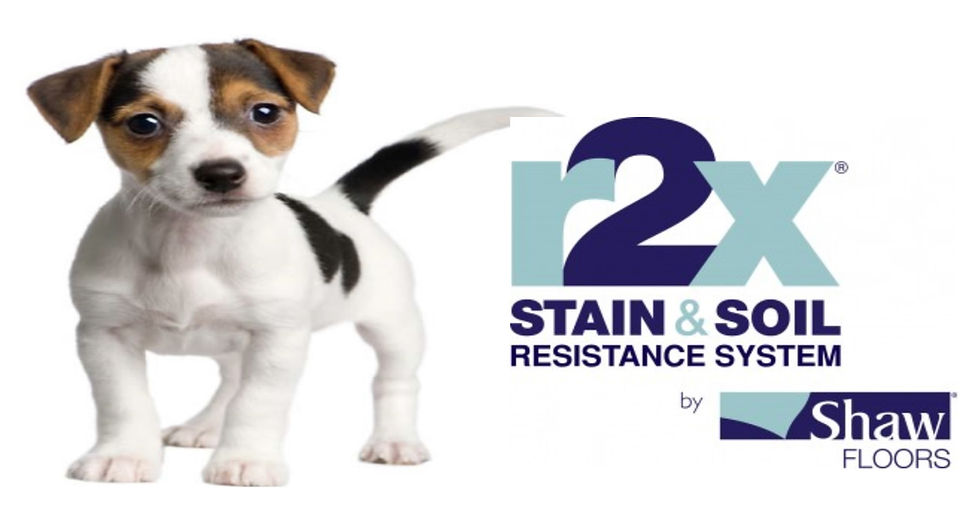
Soil Resistance: The ability of carpet fibers to repel soil or, in other words, the ability to prevent soil from sticking to the fibers. The benefit of this feature is more efficient soil removal through vacuuming and professional carpet cleaning using steam cleaning extraction methods.
“Soil” is considered to be solid particles. Since soil particles grate against carpet fibers and can work its way into the tufts, this feature is beneficial towards maintaining the textural integrity of the fibers.
Stain Resistance: The ability of carpet fibers to repel discolorants and to prevent discolorants, usually liquid products, from penetrating the fiber.
A “stain” is considered to be something that permanently discolors the carpet and is generally caused by liquid(y) spills. Items such as red wine, cleaning products, mustard, urine, blood, and coffee are notorious for creating carpet stains.
Some soil and stain resistance products are built into the fiber and some are applied topically after the fibers are extruded into their solid state. Superior soil and stain resistant properties are found in those products that have the resistance built into the fiber and not merely applied topically.
Learn about the stain and soil resistance properties found in SmartStrand Forever Clean by Mohawk Floors, Shaw Floors R2X protection, and solution dyed carpet.
Dupont Sorona SmartStrand
SmartStrand Demo Video Below

Dupont Sorona SmartStrand yarns offer soil and stain resistance that never wears off or washes off and it's only available by Mohawk Floors.
"After 10 years, Mohawk has made the best carpet in the world even better. SmartStrand Forever Clean is the only carpet that lets you have it all—unbeatable spill protection, permanent stain resistance, long-lasting durability, and so much more.
0% moisture absorption to reduce pet odors in the carpet fiber
Nanoloc™ spill and soil shield for quick and easy cleanup
3X easier to clean dirt, hair, and pet dander
Lifetime, built-in stain protection"
-Mohawk Floors
Learn more about Nanoloc spill and soil shield and the built in stain free features of Mohawk's Dupont Sorona SmartStrand.
Watch Mohawk's SmartStrand carpet come clean after a month in a Rhino's den.
R2X = Resistance x's 2
Shaw Floors Revolutionary Stain and Soil Resistance for Carpet

R2X Stain and Soil Resistance System: What makes it so different?
Here is what Shaw Floors has to say about their R2X Product.
"We first introduced our patented and exclusive R2X; Stain and Soil Resistance system in 2001 after years of research and testing. It quickly became the industry's fastest-growing protective carpet treatment. Its been hailed as a new generation in carpet technology and is as much of an innovation today as the first carpet stain and soil treatments were decades ago.
R2X is the industry's most innovative carpet stain and soil repelling system and the product of years of research and testing. Shaw's exclusive R2X system goes beyond conventional repellents that only protect the surface of the carpet. With R2X, carpets are armed with total fiber coverage, offering complete protection from the top to the bottom of the yarn. This total fiber coverage offers unprecedented protection against household spills and everyday soiling. With R2X, spills that reach the base of the yarn don't penetrate and wick back to the top as they do with conventional solutions.
In testing, R2X demonstrated superior carpet stain resistance on two levels. First, it provides better initial protection. Second, it allows more time to react to a problem. Another significant benefit of R2X is its effectiveness with polyester and polypropylene fibers. Most polyester and polypropylene carpets have an inherent tendency to attract soil. Topical soil carpet treatments are only "skin deep," and the limited protection they offer wears away after cleaning or normal wear and tear. In contrast, R2X continues to perform well even after repeated cleanings. The performance of nylon, polyester, and polypropylene treated with ordinary systems begins to diminish. And of course, Shaw's warranty protection ensures customer satisfaction, time after time."
-Shaw Floors
Solution Dyed Carpet Yarn
Dyeing Synthetic Carpet Yarn

Dyeing synthetic carpet yarn boils down to two options: Solution Phase and Post Solution Phase.
Solution dyed yarn is synthetic yarn that has dye added during its solution (liquid) phase. The process of adding dye during this primary phase of creating yarn increases stain resistance in comparison to the other option of dyeing yarn after it has been extruded and solidified. The yarn is essentially "sealed" since the solution dyed method eliminates dye sites and therefore eliminates uptake of other stain inducing colorants, such as urine or red wine, into the interior of the fiber. Nonetheless, this method of dyeing does not eliminate the possibility of staining altogether. Certain items can coat and permanently adhere to the yarn. Ink is a notorious culprit for this type of stain.
Post solution phase is synthetic yarn dyed after the yarn has been extruded (thrust through machinery to create a synthetic yarn's shape) and solidified. In order for color uptake to occur in the yarn, dye sites (tiny holes pierced into the yarn) are added. Of course, if dye can uptake into the interior of the yarn through dye sites, so can other unwanted colorants including red wine or urine; therefore, solution dyeing is preferred for stronger stain resistance.
Carrot vs. Radish Myth:
Myths have been circulating about solution dyed verses post solution dyed. The myth is the "carrot vs. radish" claim. The carrot-radish claim portrays a solution dyed yarn like a carrot with the dye completely infusing the color throughout the yarn while a post solution yarn is like a radish and is merely coated with color. The truth is that both methods of dyeing infuse color throughout the yarn. As stated earlier, the weakness in the post solution dyed yarn are the dye sites providing a pathway for other colorants to infiltrate the interior of the yarn and creating permanent discoloration. Check out this video by Shaw Floors demonstrating this fact.

Kommentarer